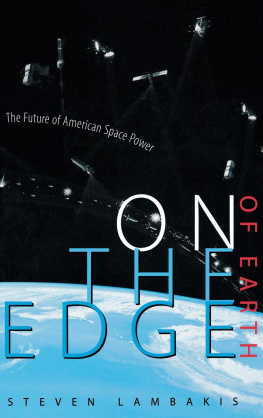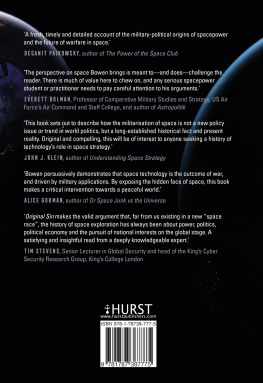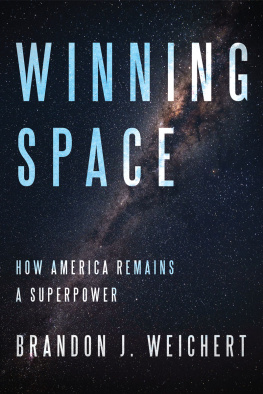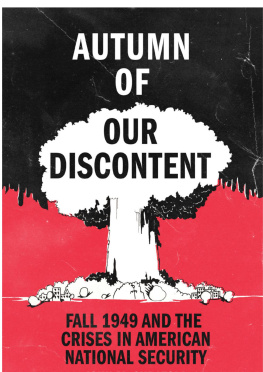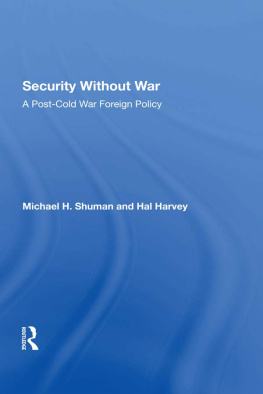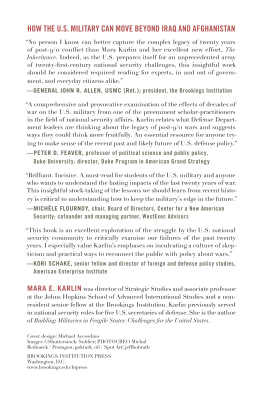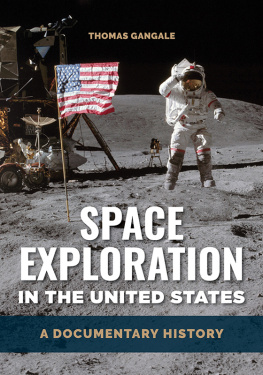O N THE E DGE OF E ARTH
O N THE E DGE OF E ARTH
The Future of American Space Power
Steven Lambakis
T HE U NIVERSITY P RESS OF K ENTUCKY
Copyright 2001 by The University Press of Kentucky
Scholarly publisher for the Commonwealth, serving Bellarmine University,
Berea College, Centre College of Kentucky, Eastern Kentucky University,
The Filson Historical Society, Georgetown College, Kentucky Historical Society,
Kentucky State University, Morehead State University, Murray State University,
Northern Kentucky University, Transylvania University, University of Kentucky,
University of Louisville, and Western Kentucky University.
All rights reserved.
Title page: This near-infrared photograph of the Earth was taken by the Galileo spacecraft at 6:07 a.m. PST on Dec. 11, 1990, at a range of about 1.32 million miles. The camera used light with a wavelength of 1 micron, which easily penetrates atmospheric hazes and enhances the brightness of land surfaces. South America is prominent near the center; at the top, the East Coast of the United States, including Florida, is visible. The West Coast of Africa is visible on the horizon at the right. Photo from the National Aeronautics and Space Administration archives.
Editorial and Sales Offices: The University Press of Kentucky
663 South Limestone Street, Lexington, Kentucky 40508-4008
www.kentuckypress.com
12 11 10 09 086 5 4 3 2
Library of Congress Cataloging-in-Publication Data
Lambakis, Steven James.
On the edge of Earth : the future of American space power / Steven Lambakis
p.cm.
Inclues bibliographical references.
ISBN-10: 0-8131-2198-1 (cloth : alk. paper)
1. Astronautics and stateUnited States. 2. AstronauticsUnited StatesPlanning. 3. National securityUnited States. I. Title.
| TL789.8.U5L352001 | 00-012288 |
387.80973dc21
ISBN-13 : 978-0-8131-2198-7 (cloth : alk. paper)
This book is printed on acid-free recycled paper meeting the requirements of the American National Standard for Permanence in Paper for Printed Library Materials.

Manufactured in the United States of America.
 | Member of the Association of American University Presses |
C ONTENTS



For Tracie,
always and forever my source of joy,
and for Matthew, Lindsey, and Alexander,
for whom the future waits

A CKNOWLEDGMENTS
This book would not have been possible without the assistance of the Smith Richardson Foundation. My appreciation to the people of Smith Richardson who saw a compelling need to produce this book and who elected to throw their trust and support behind me is beyond measure. The foundations generous sponsorship allowed me to devote considerable time over a period of two years to explore the subject matter of this book.
For their special counsel, oversight, and criticism, I would like to recognize three individuals. Dr. William R. Graham, President of National Security Research, Inc. and former Science Advisor to President Reagan, offered historical insight and invaluable policy and technical advice. Our conversations were an immense help. I also am deeply indebted to Dr. Colin S. Gray, Professor of International Politics and Strategic Studies at the University of Reading in the United Kingdom. Dr. Gray not only is a keen critic at the levels of policy and strategy, but his historical knowledge and expertise in military and defense affairs proved to be important guideposts for me. Finally, I am grateful for the perceptive counsel of Mr. Richard W. Scott Jr., who at various stages in his career worked in the defense, civil, and commercial space sectors in the United States. I found his experience in policy, military, and technical matters to be very helpful. I also would like to acknowledge the special contributions he made to the development of .
While I have followed and analyzed the space power subject since the early 1990s, writing this book was a tremendous learning experience for me. My conversations and interviews with numerous individuals during 1998 and 1999 enhanced the quality of this work. There are several people I would like to thank, many of whom took time out of very busy schedules to meet with me or to review and comment on portions of this manuscript. I am ever appreciative for their insights and helpful comments. In alphabetical order, they are: Colonel David Anhalt, USAF (Assistant to the Director, Office of Net Assessments, U.S. Defense Department); Commander Thomas Berg, USN (U.S. Space Command liaison to the U.S. Ballistic Missile Defense Organization); Mr. Marc Berkowitz (Space Policy Director for the Assistant Secretary of Defense for Command, Control, Communications and Intelligence in the U.S. Defense Department); Major Brad Broemmel, USAF (Air Force Space Command staff); Ambassador Henry Cooper (Chairman of High Frontier); Mr. Charles Cunningham (Deputy Assistant Secretary of Defense for Intelligence, the U.S. Defense Department); Major General Robert Dickman, USAF (U.S. National Space Architect); Colonel Wayne Dillingham, USAF (Legal Advisor, U.S. Space Command); Brigadier General Stephen Ferrell, USA (Director of Strategy and Plans, U.S. Space Command); Colonel Bill Fruland, USAF (Directorate for Operations, U.S. Space Command); Dr. Robert Fugate (Senior Scientist and Technical Advisor, U.S. Air Force Research Laboratory); Mr. Wayne Glass (Defense Legislative Assistant for U.S. Senator Jeff Bingaman); Dr. Daniel Goure (Center for Strategic and Security Studies); Mr. Brian Greene (staff member on the U.S. House Armed Services Committee); Mr. Dana Krupa (Assistant to U.S. Senator Jeff Bingaman); Mr. Christopher Lay (SAIC); Lieutenant General Lester L. Lyles, USAF (Director of the U.S. Ballistic Missile Defense Organization); Mr. Andrew Marshall (Director, Office of Net Assessments, U.S. Defense Department); Lieutenant Colonel Sam McCraw, USAF (Air Force Space Com-mand staff); Lieutenant Colonel Cynthia McKinley, USAF (Commander, 21st Space Wing, Air Force Space Command); Mr. E. Clayton Mowry (President, Satellite Industry Association); Mr. James Muncy (Defense Legislative Assistant for Congressman Dana Rohrabacher); Dr. Mitch Nikolich (Senior Analyst, National Security Research, Inc.); Mr. Pete Norris (President, SPIN-2); Major Perry Nouis, USAF (Public Affairs, U.S. Space Command); Colonel James Painter, USAF (Chief, Policy and International Affairs Division, U.S. Space Command); Lieutenant Colonel Anthony Russo, USAF (Space Warfare Center, Air Force Space Command); General Bernard Schriever, USAF Retired (pioneering program manager for the U.S. Atlas ICBM Program); Mr. Andrei Shoumikin (National Institute for Public Policy); Mr. Gil Siegert (Space Ventures); Captain Don Slaton (U.S. Joint Chiefs of Staff, Space Division); Ms. Marcia Smith (Congressional Research Service); Mr. Robert Snyder (Executive Director, Ballistic Missile Defense Organization); Mr. Eric Sterner (Legislative Assistant for Congressman James Sensenbrenner); Dr. Thomas Ward (Director, Threat and Countermeasures, Ballistic Missile Defense Organization); Rear Admiral Richard West, USN (Deputy Director, Ballistic Missile Defense Organization); Brigadier General (sel) Simon Pete Worden, USAF (Deputy Chief of Staff for Air and Space Operations).

